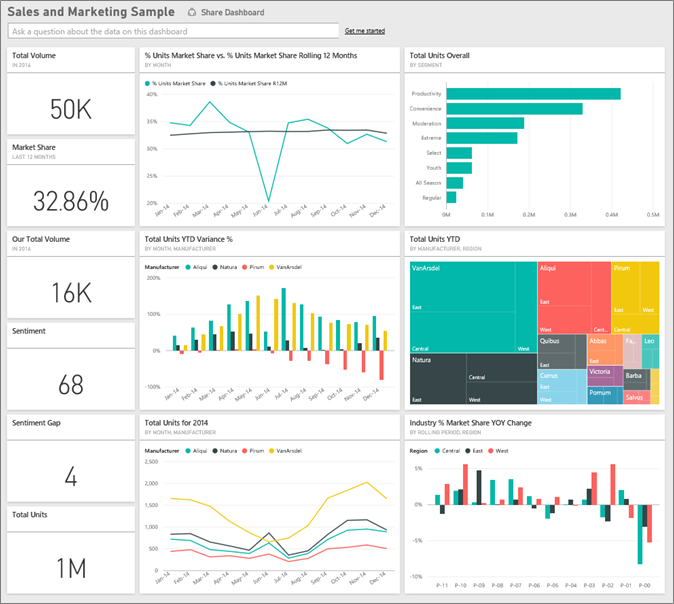What Is ERP Integration with Power BI
Integrating an ERP system with Power BI is the process of combining operational data stored in the ERP system with the advanced analytical and visualization capabilities of Power BI. This allows organizations to analyze data in real time, regardless of its source, and present it in the form of intuitive, actionable reports.
ERP systems (Enterprise Resource Planning) are designed to manage business processes comprehensively — from finance, through production, to sales and logistics. Some of the most popular solutions include SAP, Microsoft Dynamics 365, Comarch ERP XL, and enova365. Each generates large volumes of data that, without the right tools, can be difficult to leverage effectively for decision-making.
In this context, Power BI becomes a natural extension of ERP capabilities, enabling:
- Automatic data integration from multiple sources,
- Creation of interactive dashboards,
- Real-time tracking of key performance indicators (KPIs),
- Clear presentation of results across all departments.
As a result, integrating ERP with Power BI allows companies to move from static reports to dynamic data analysis, supporting fast and precise business decisions.
How Power BI Solves These Challenges
Integrating an ERP system with Power BI helps companies eliminate common reporting and data analysis problems. Instead of working with outdated or fragmented information, managers receive a consistent, up-to-date view of business performance in a single tool.
Automatic Data Refresh
Power BI allows reports to be refreshed automatically at scheduled intervals. This ensures that all data — from ERP and external sources alike — is always current. In practice, this means real-time reports that accurately reflect the company’s situation at any moment.
Connecting Data from Multiple Sources
Power BI is not limited to a single system. It integrates information from ERP, CRM, Excel, financial, marketing, and production systems, creating a centralized data repository that simplifies analysis from different perspectives — from sales performance to project profitability.
Interactive Dashboards
Instead of static reports, users gain access to interactive dashboards, enabling them to filter, explore, and compare data intuitively. Each department can monitor its own KPIs, customizing views to meet specific business needs.
24/7 Access
Power BI provides full access to data from computers, tablets, or smartphones. Managers no longer need to wait for IT to generate reports — they can check results anytime, anywhere.
Data Security
Microsoft ensures advanced access controls compliant with internal company policies and data protection regulations. Each user sees only the information they are authorized to access.
With these features, Power BI not only streamlines reporting but also builds trust in the data and accelerates decision-making across the organization.

Example Scenario: Power BI + ERP in Practice
Let’s imagine a trading company that uses an ERP system daily to manage orders and invoices, while a CRM system collects data on customers and sales activities. Additionally, some financial analyses are still conducted in Excel spreadsheets.
Without integration, all this data exists separately, making it difficult to get a comprehensive view of the company’s performance. After integrating the ERP system with Power BI, data from ERP, CRM, and Excel flows into a single analytical model. The result?
- A sales dashboard displaying revenue, cost, and margin trends in real time.
- The ability to filter data by regions, products, or sales representatives.
- Automated alerts triggered when results deviate from the plan — for example, a drop in sales in a specific segment.
Instead of manually compiling reports from multiple sources, managers now have a complete picture of business performance in one place. This visualization allows them to respond faster and make data-driven decisions rather than relying on intuition.
How to Start ERP Integration with Power BI
Integrating an ERP system with Power BI is a project that requires careful planning. Here are the steps to execute this process efficiently and effectively:
- Assess the current reporting system – evaluate how data is currently collected and which processes need improvement.
- Identify key data sources and KPIs – determine the metrics that have the most significant impact on business decisions (e.g., sales, inventory, costs).
- Select an implementation partner, such as our company, with experience in integrating Power BI with ERP systems to design the data architecture and oversee the reporting process.
- Train your team – implementing the tool is just the beginning. It is crucial that users can not only operate Power BI but also interpret data and extract actionable insights.
A well-designed integration ensures that reporting becomes not only faster but also more valuable for business decision-making.
Summary
Integrating ERP systems with Power BI is a step toward modern, data-driven business management. By combining information from multiple systems, companies gain a single, unified view of business reality — accessible in real time.
Instead of spending time gathering data from various sources, teams can focus on analysis and action. This translates into faster decision-making, increased efficiency, and better results.
If your company wants to move from reactive reporting to proactive data management, it is worth starting this process with an experienced technology partner — such as EBIS, which has supported companies for years in Power BI implementations and ERP integrations.
